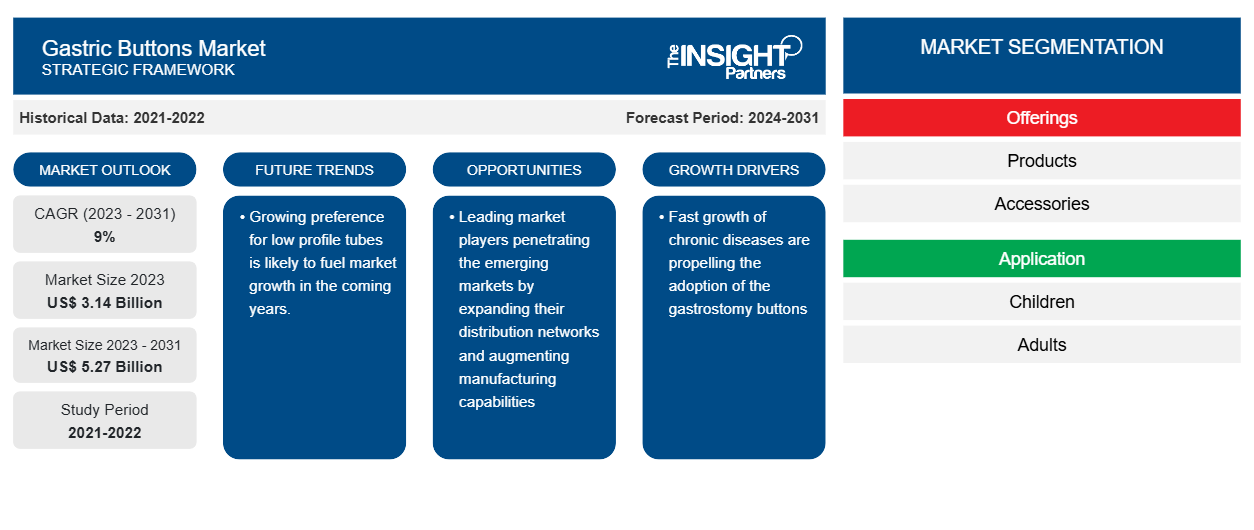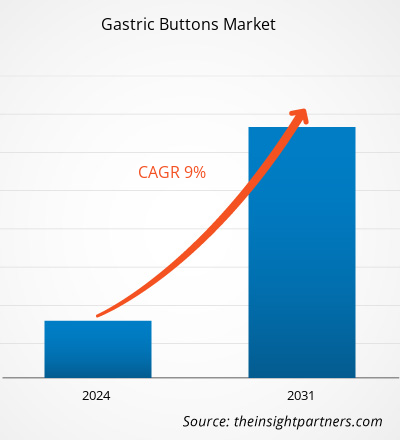The gastric buttons market size is projected to reach US$ 5.27 billion by 2031 from US$ 3.14 billion in 2023. The market is expected to register a CAGR of 9.0% during 2023–2031. Growing preference for low-profile tubes will likely remain a key trend in the market.
Gastric Buttons Market Analysis
Key factors driving the market growth include the increasing prevalence of cancer, neurological disorders, diabetes, and gastrointestinal diseases and the rising geriatric population. Furthermore, the untapped potential of emerging economies is a key opportunity for the gastric buttons market players.
Gastric Buttons Market Overview
Diabetes is a life-threatening chronic disease with no functional cure. Diabetes can lead to various complications in different body parts and increase the overall risk of premature death. Heart attack, stroke, kidney failure, leg amputation, vision loss, and nerve damage are the major complications associated with diabetes. As there is a significant increase in diabetes cases worldwide, it results in life-changing complications among the population. According to the International Diabetes Federation (IDF), in 2017, 46 million diabetic patients were reported in North America, which is expected to reach 62 million in 2045.
Customize This Report To Suit Your Requirement
You will get customization on any report - free of charge - including parts of this report, or country-level analysis, Excel Data pack, as well as avail great offers and discounts for start-ups & universities
Gastric Buttons Market: Strategic Insights

-
Get Top Key Market Trends of this report.This FREE sample will include data analysis, ranging from market trends to estimates and forecasts.
Gastric Buttons Market Drivers and Opportunities
Rising Geriatric Population
The geriatric population has been rising significantly worldwide. The rise in geriatric population in developed countries, such as the US, the UK, Canada, and Japan, and developing countries, such as China, India, and South Korea, is driven by the modernization of healthcare facilities and improvements in healthcare services, which has boosted the life expectancy in these countries. An increase in life expectancy is leading to a rising geriatric population globally. According to the data presented by the World Health Organization (WHO) in February 2018, the geriatric population is estimated to rise from 12% in 2015 to 22% by 2050.
Untapped Potential of Emerging Economies
Sales of gastric buttons are predicted to rise in response to the need for improved delivery methods, enteral nutrition (EN), and enteral feeding in home care settings. By strengthening their production capabilities and diversifying their distribution networks, major market participants are gaining a greater foothold in new countries. For major producers of stomach buttons, emerging markets in South Korea, Mexico, Brazil, and India are anticipated to present development prospects in the years to come. This can be linked to several factors, including an aging population, a high incidence of neurological disorders, cancer, diabetes, and gastrointestinal ailments, an increase in disposable income, better infrastructure for healthcare, and an increase in medical tourism in these nations. Due to comparatively less restrictive rules, Asia Pacific has developed into a center that is flexible and hospitable to business. The majority of participants are turning their attention to emerging economies as the US and European markets mature. Upgrading the newest technologies in emerging nations is mostly dependent on large investments made in health and life sciences research. This will therefore reinforce the propensity to employ gastric buttons.
Gastric Buttons Market Report Segmentation Analysis
Key segments that contributed to the derivation of the gastric buttons market analysis are offerings, usage, and end users.
- Based on offering, the gastric buttons market is segmented into products and accessories. The products segment held the most significant market share in 2023.
- Based on usage, the gastric buttons market is bifurcated into enteral nutrition, medications, fluids, and others. The enteral nutrition segment held the most significant market share in 2023.
- Based on end users, the gastric buttons market is segmented by hospitals, clinics, and others. The hospital's segment held the largest market share in 2023.
Gastric Buttons Market Share Analysis by Geography
The geographic scope of the gastric buttons market report is mainly divided into five regions: North America, Asia Pacific, Europe, Middle East & Africa, and South & Central America.
In North America, the US is the largest market; the US gastric buttons market holds the largest share in the North American region. The rising prevalence of chronic diseases is likely to favor market growth. Chronic diseases such as cancer, stroke, neurological disorders, and paralysis are the leading causes of disability and death in the US. Six out of ten Americans, according to the National Center for Chronic Disease Prevention and Health Promotion, have at least one chronic illness, including diabetes, cancer, heart disease, and stroke. Growing spending on long-term medical issues will probably support market expansion. Furthermore, the US spent a total of US$3.7 trillion on treating chronic illnesses in 2020 or almost 19.6% of its GDP.
Gastric Buttons Market Regional Insights
The regional trends and factors influencing the Gastric Buttons Market throughout the forecast period have been thoroughly explained by the analysts at The Insight Partners. This section also discusses Gastric Buttons Market segments and geography across North America, Europe, Asia Pacific, Middle East and Africa, and South and Central America.
Gastric Buttons Market Report Scope
| Report Attribute | Details |
|---|---|
| Market size in 2023 | US$ 3.14 Billion |
| Market Size by 2031 | US$ 5.27 Billion |
| Global CAGR (2023 - 2031) | 9% |
| Historical Data | 2021-2022 |
| Forecast period | 2024-2031 |
| Segments Covered |
By Offerings
|
| Regions and Countries Covered |
North America
|
| Market leaders and key company profiles |
|
Gastric Buttons Market Players Density: Understanding Its Impact on Business Dynamics
The Gastric Buttons Market is growing rapidly, driven by increasing end-user demand due to factors such as evolving consumer preferences, technological advancements, and greater awareness of the product's benefits. As demand rises, businesses are expanding their offerings, innovating to meet consumer needs, and capitalizing on emerging trends, which further fuels market growth.

- Get the Gastric Buttons Market top key players overview
Gastric Buttons Market News and Recent Developments
The Gastric Buttons Market is evaluated by gathering qualitative and quantitative data post primary and secondary research, which includes important corporate publications, association data, and databases. A few of the developments in the gastric buttons market are listed below:
- Phathom Pharmaceuticals, Inc., a biopharmaceutical company focused on developing and commercializing novel treatments for gastrointestinal diseases, announced today the FDA has accepted for review the company’s NDA for VOQUEZNA (vonoprazan) as a daily treatment of heartburn associated with Non-Erosive gastroesophageal reflux disease (GERD) in adults. (Source: Phathom Pharmaceuticals, Inc., Company Website, December 2023)
Gastric Buttons Market Report Coverage and Deliverables
The “Gastric Buttons Market Size and Forecast (2021–2031)” report provides a detailed analysis of the market covering below areas:
- Gastric buttons market size and forecast at global, regional, and country levels for all the key market segments covered under the scope
- Gastric buttons market trends as well as market dynamics such as drivers, restraints, and key opportunities
- Detailed PEST/Porter’s Five Forces and SWOT analysis
- Gastric buttons market analysis covering key market trends, global and regional framework, major players, regulations, and recent market developments.
- Industry landscape and competition analysis covering market concentration, heat map analysis, prominent players, and recent developments for the gastric buttons market
- Detailed company profiles
Frequently Asked Questions
Which region dominated the gastric buttons market in 2023?
What are the driving factors impacting the gastric buttons market?
What are the future trends of the gastric buttons market?
Which are the leading players operating in the gastric buttons market?
What is the expected CAGR of the gastric buttons market?
- Historical Analysis (2 Years), Base Year, Forecast (7 Years) with CAGR
- PEST and SWOT Analysis
- Market Size Value / Volume - Global, Regional, Country
- Industry and Competitive Landscape
- Excel Dataset
Recent Reports
Testimonials
Reason to Buy
- Informed Decision-Making
- Understanding Market Dynamics
- Competitive Analysis
- Identifying Emerging Markets
- Customer Insights
- Market Forecasts
- Risk Mitigation
- Boosting Operational Efficiency
- Strategic Planning
- Investment Justification
- Tracking Industry Innovations
- Aligning with Regulatory Trends





















 Get Free Sample For
Get Free Sample For